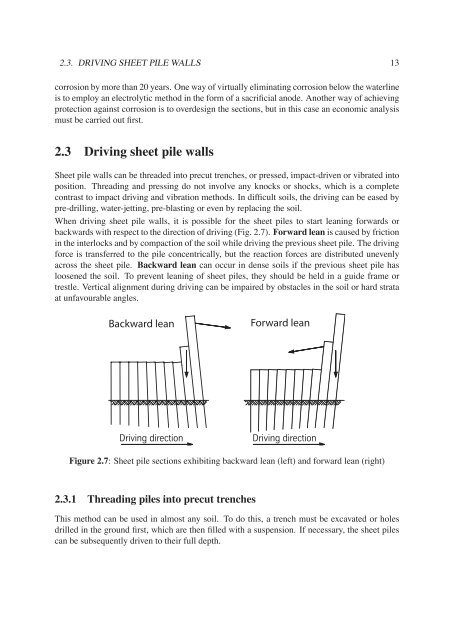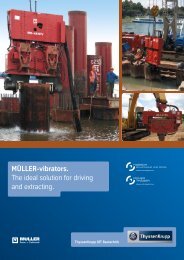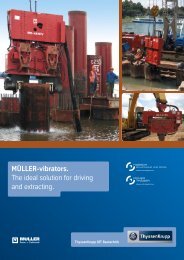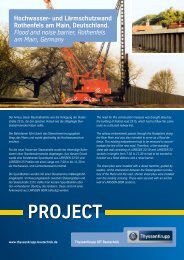pdf (3.6 MB) - ThyssenKrupp Bautechnik
pdf (3.6 MB) - ThyssenKrupp Bautechnik
pdf (3.6 MB) - ThyssenKrupp Bautechnik
Create successful ePaper yourself
Turn your PDF publications into a flip-book with our unique Google optimized e-Paper software.
2.3. DRIVING SHEET PILE WALLS 13<br />
corrosion by more than 20 years. One way of virtually eliminating corrosion below the waterline<br />
is to employ an electrolytic method in the form of a sacrificial anode. Another way of achieving<br />
protection against corrosion is to overdesign the sections, but in this case an economic analysis<br />
must be carried out first.<br />
2.3 Driving sheet pile walls<br />
Sheet pile walls can be threaded into precut trenches, or pressed, impact-driven or vibrated into<br />
position. Threading and pressing do not involve any knocks or shocks, which is a complete<br />
contrast to impact driving and vibration methods. In difficult soils, the driving can be eased by<br />
pre-drilling, water-jetting, pre-blasting or even by replacing the soil.<br />
When driving sheet pile walls, it is possible for the sheet piles to start leaning forwards or<br />
backwards with respect to the direction of driving (Fig. 2.7). Forward lean is caused by friction<br />
in the interlocks and by compaction of the soil while driving the previous sheet pile. The driving<br />
force is transferred to the pile concentrically, but the reaction forces are distributed unevenly<br />
across the sheet pile. Backward lean can occur in dense soils if the previous sheet pile has<br />
loosened the soil. To prevent leaning of sheet piles, they should be held in a guide frame or<br />
trestle. Vertical alignment during driving can be impaired by obstacles in the soil or hard strata<br />
at unfavourable angles.<br />
Backward lean Forward lean<br />
Figure 2.7: Sheet pile sections exhibiting backward lean (left) and forward lean (right)<br />
2.3.1 Threading piles into precut trenches<br />
This method can be used in almost any soil. To do this, a trench must be excavated or holes<br />
drilled in the ground first, which are then filled with a suspension. If necessary, the sheet piles<br />
can be subsequently driven to their full depth.
















